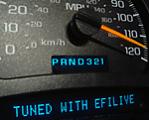Just wanted to be sure about the injector flow rate table.
It shows injector flow (lbs/h) as a function of manifold vacuum (inHg)
As the vacuum increases the flow inceases because the total pressure
differential across the injector increases (58psi constant from the pump).
It seems that the total injector flow rate is the highest when at idle (23.5inHg) and the lowest at WOT (0 inHg), exactly the reverse of what I would like to have. Also, is 23.5 inHg the max vacuum pressure at closed throttle - that's what it looks like?
You all agree?
Gert



 Reply With Quote
Reply With Quote
 If not someone quickly correct me.
If not someone quickly correct me.



